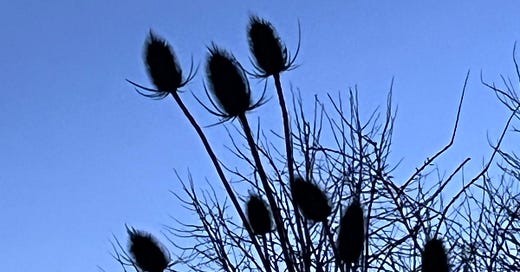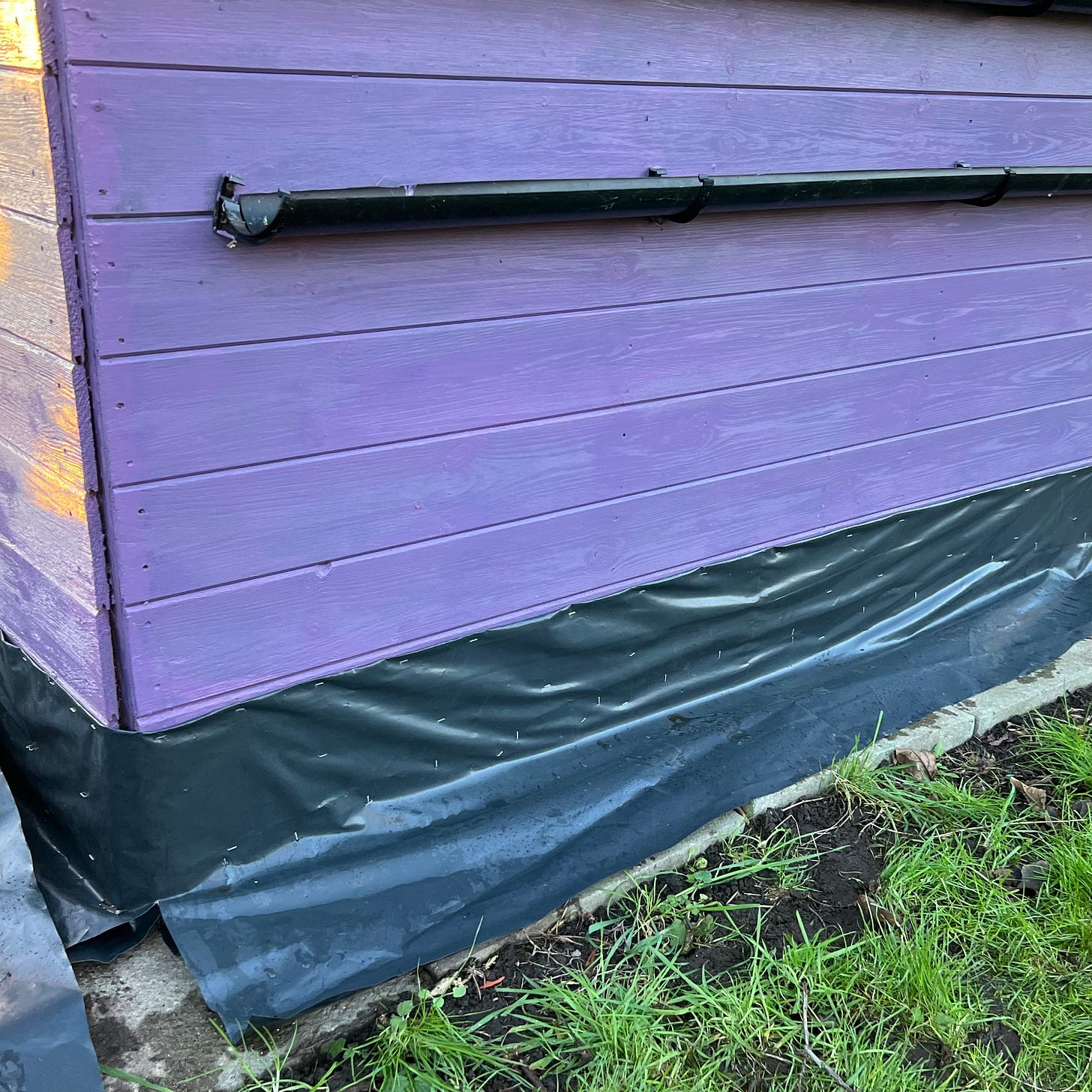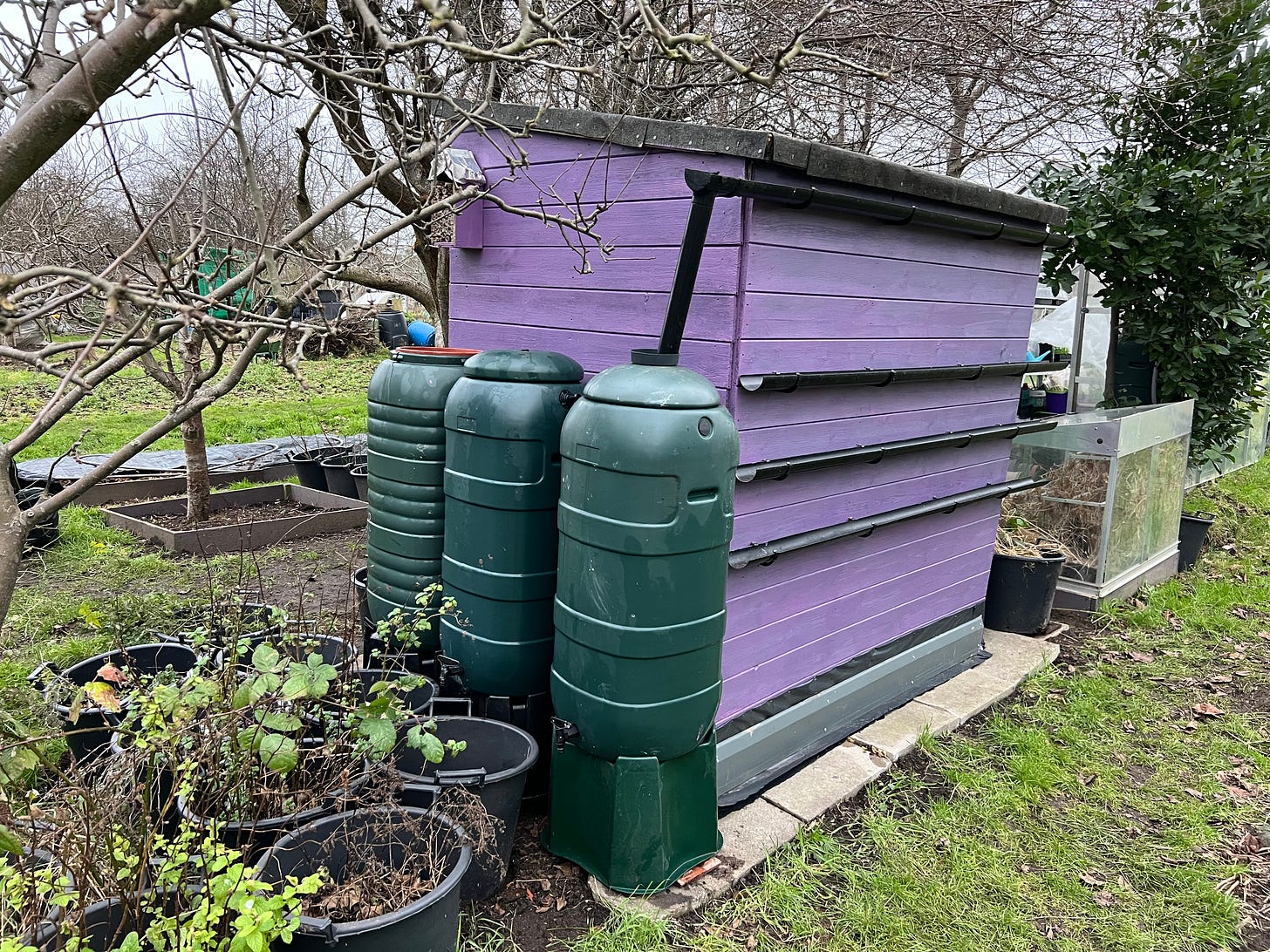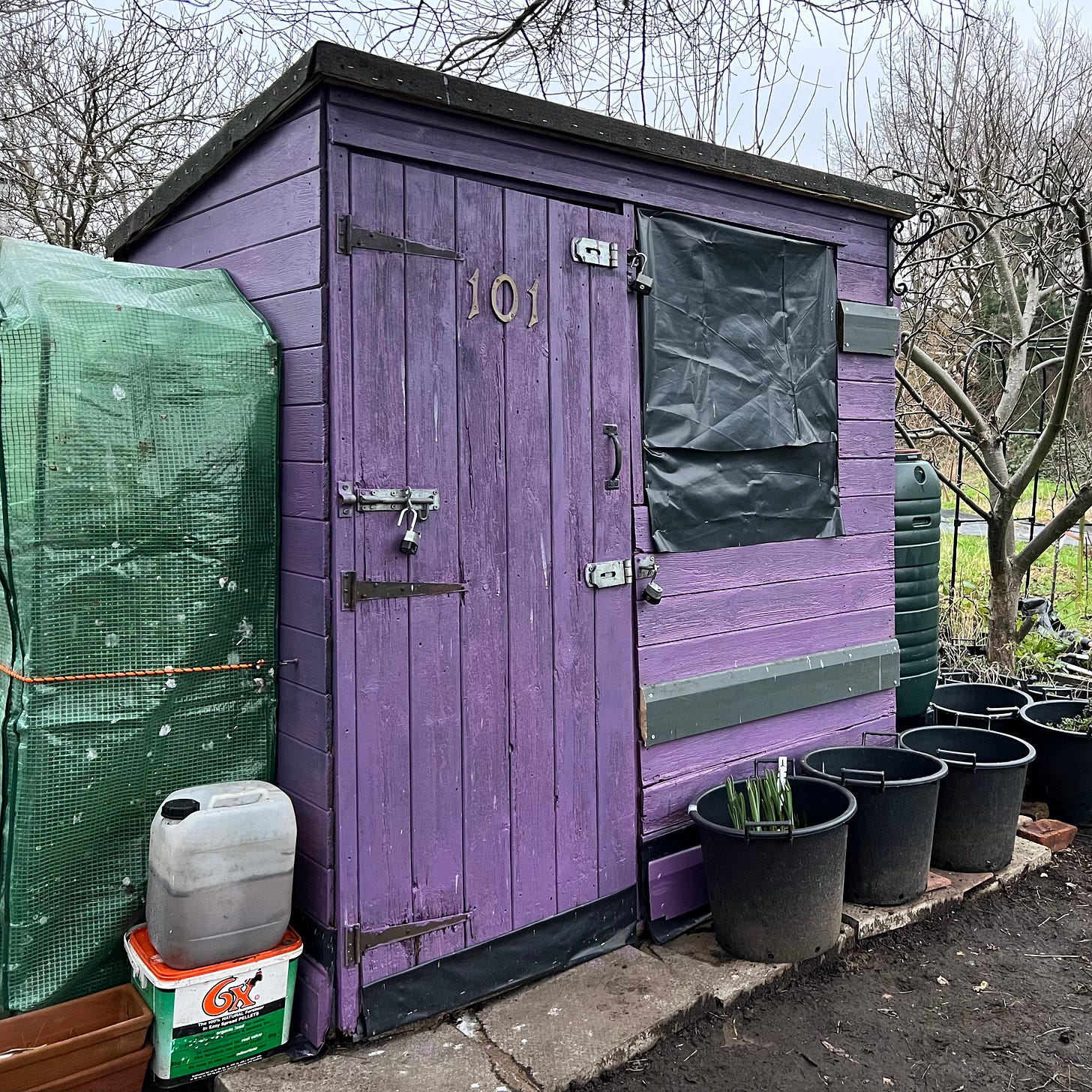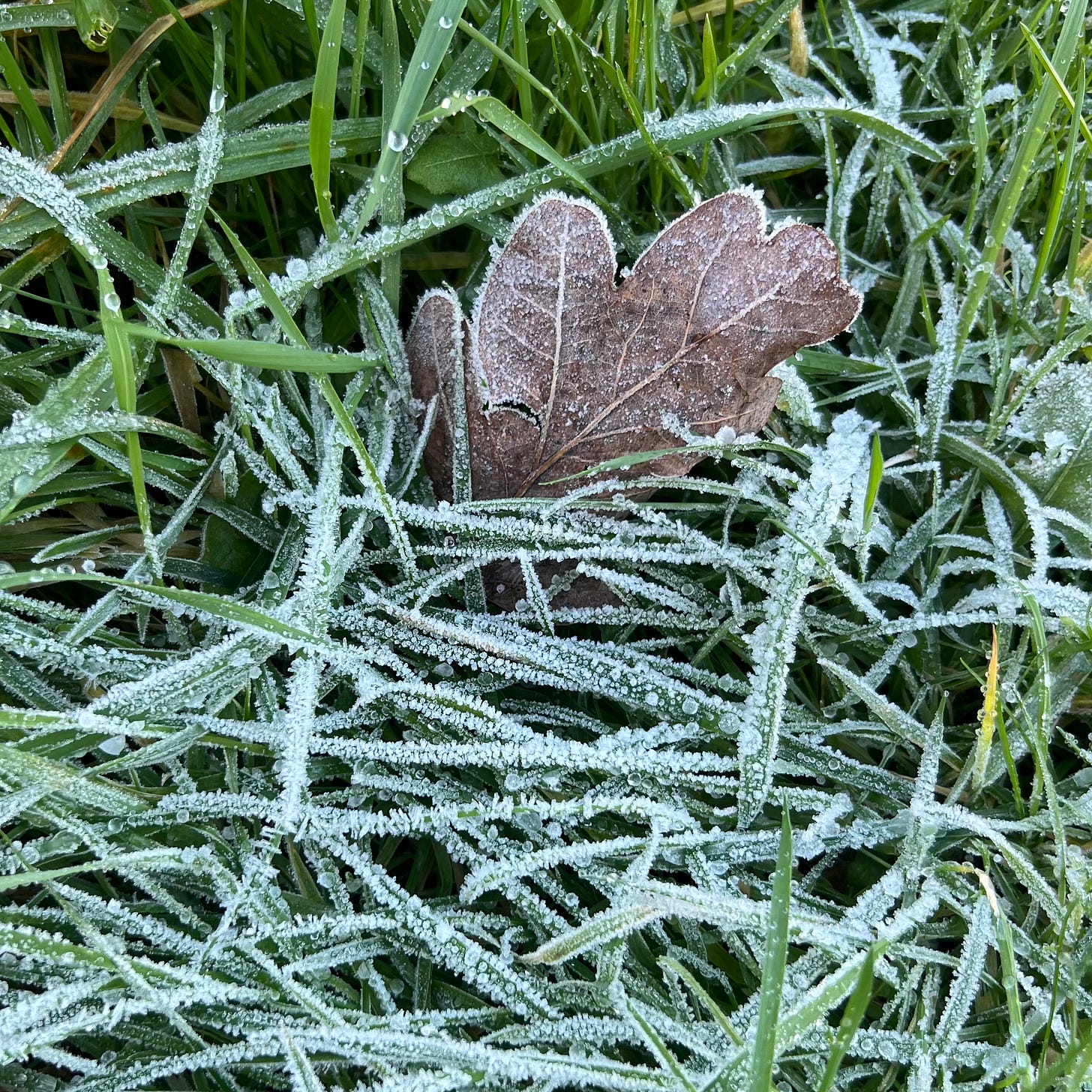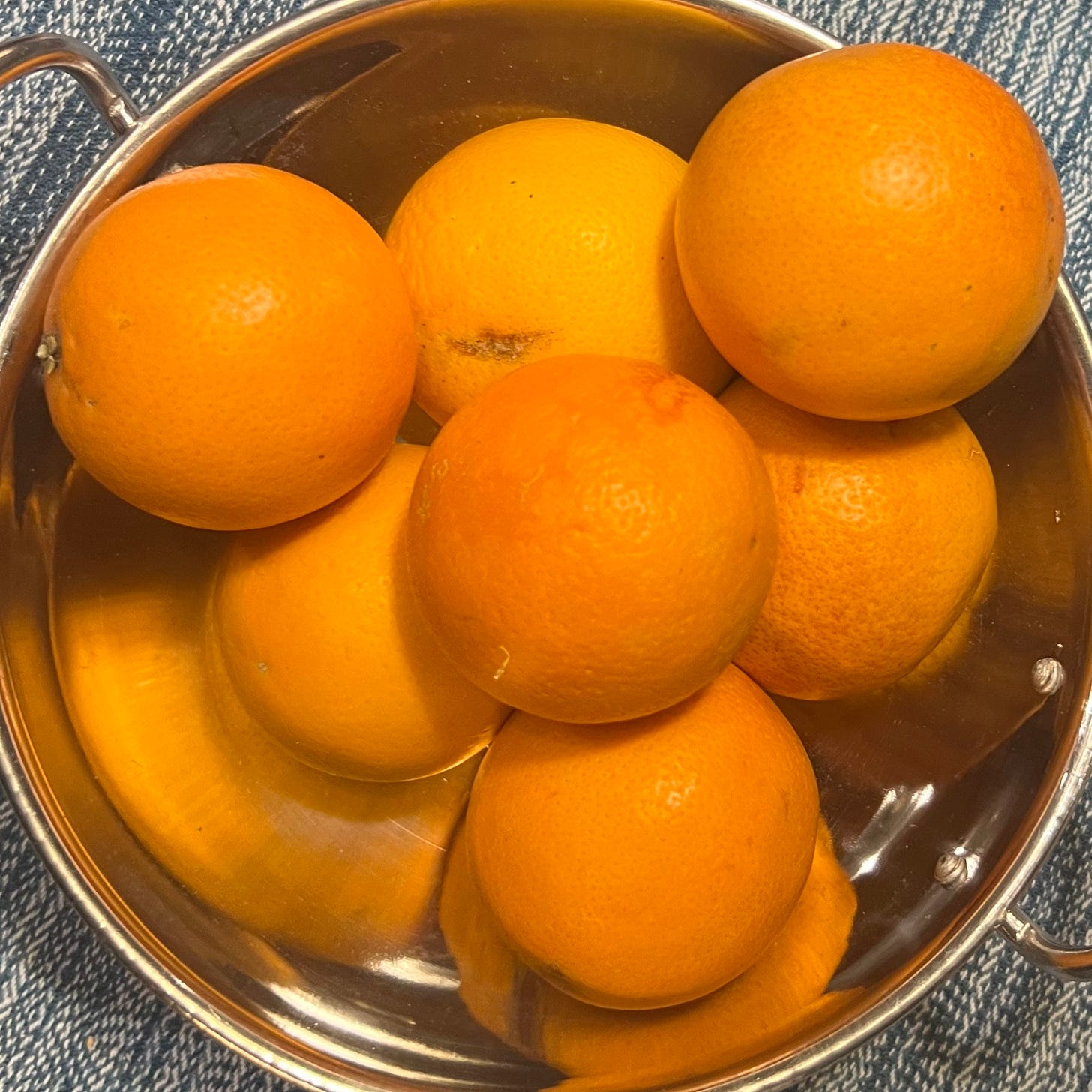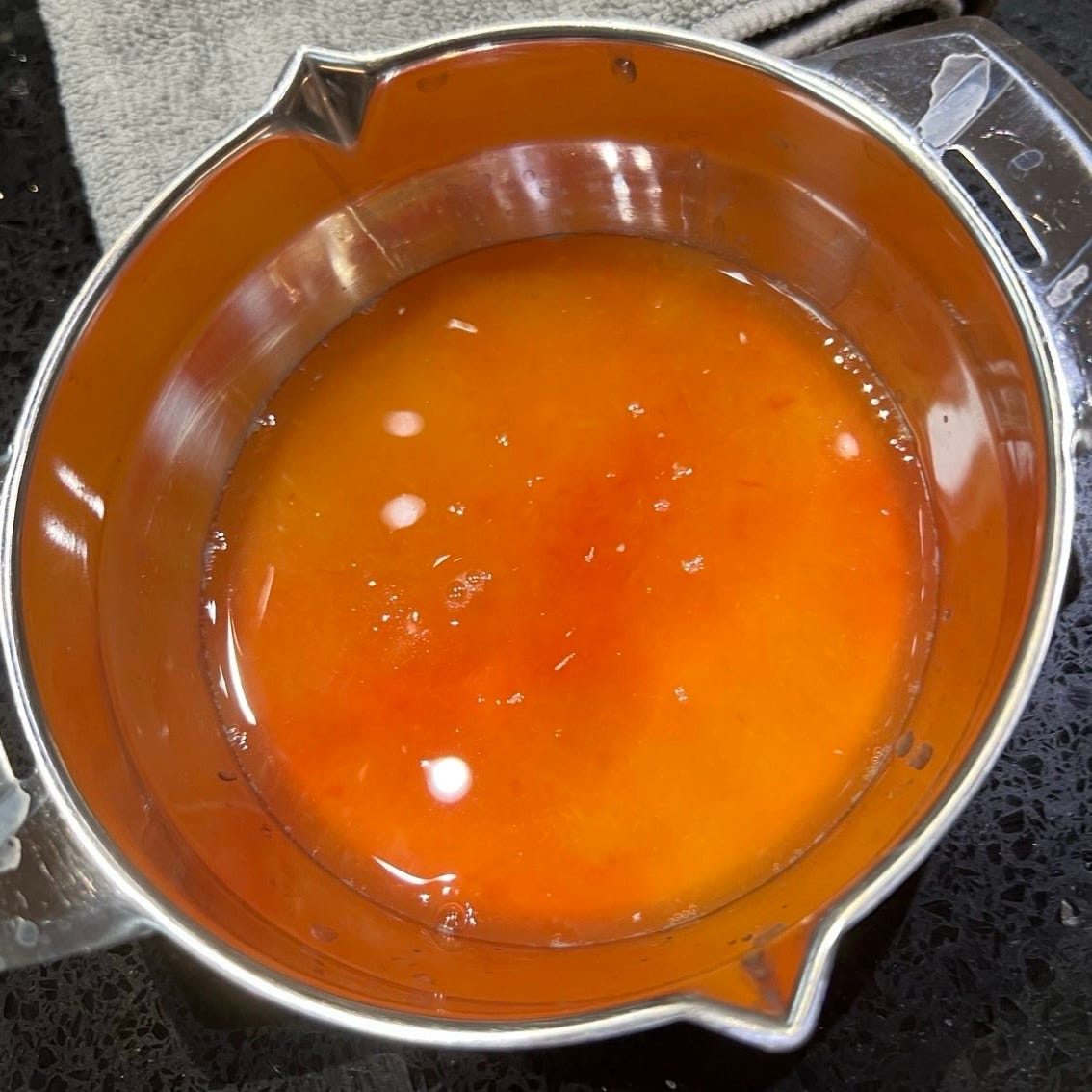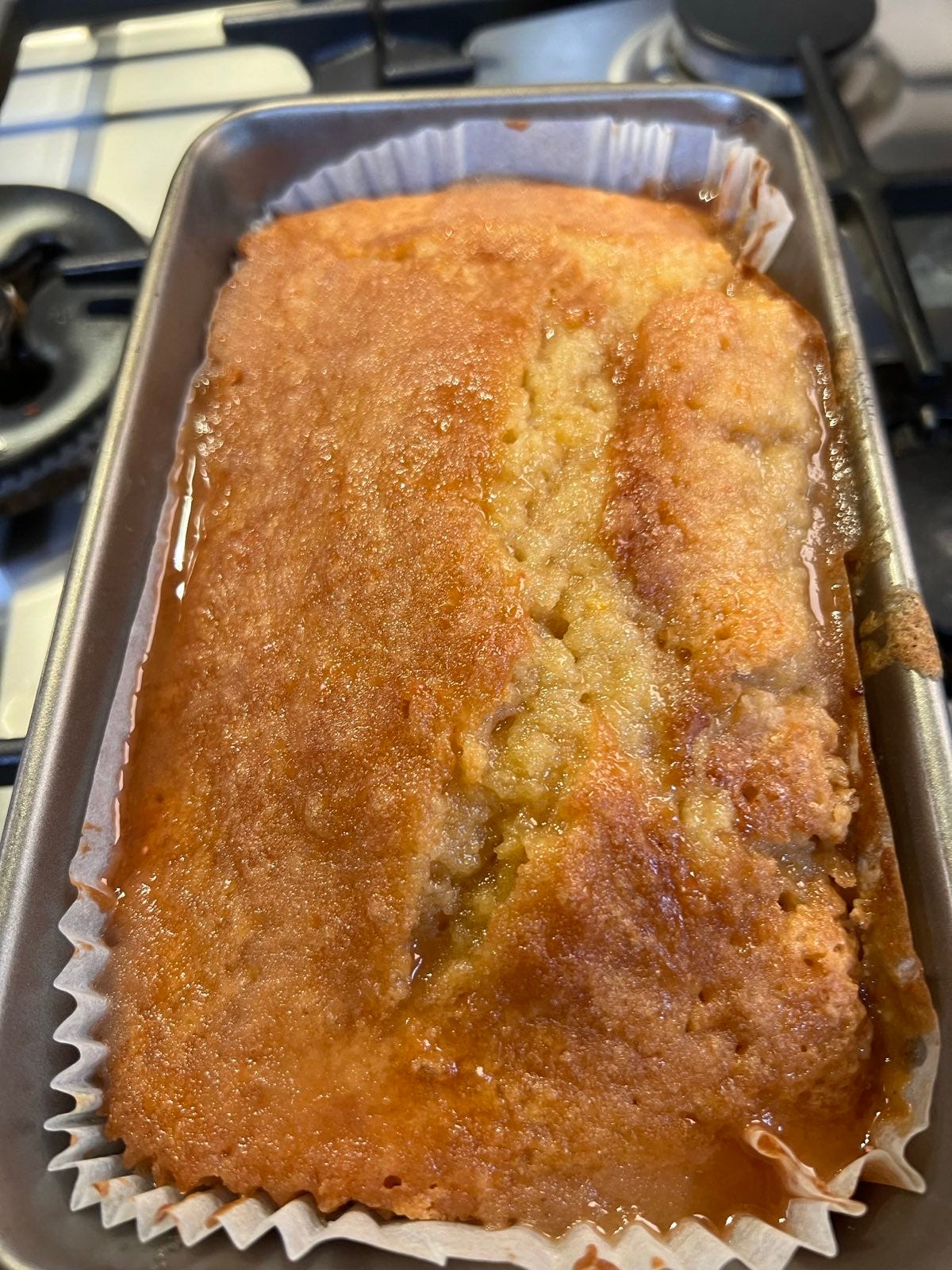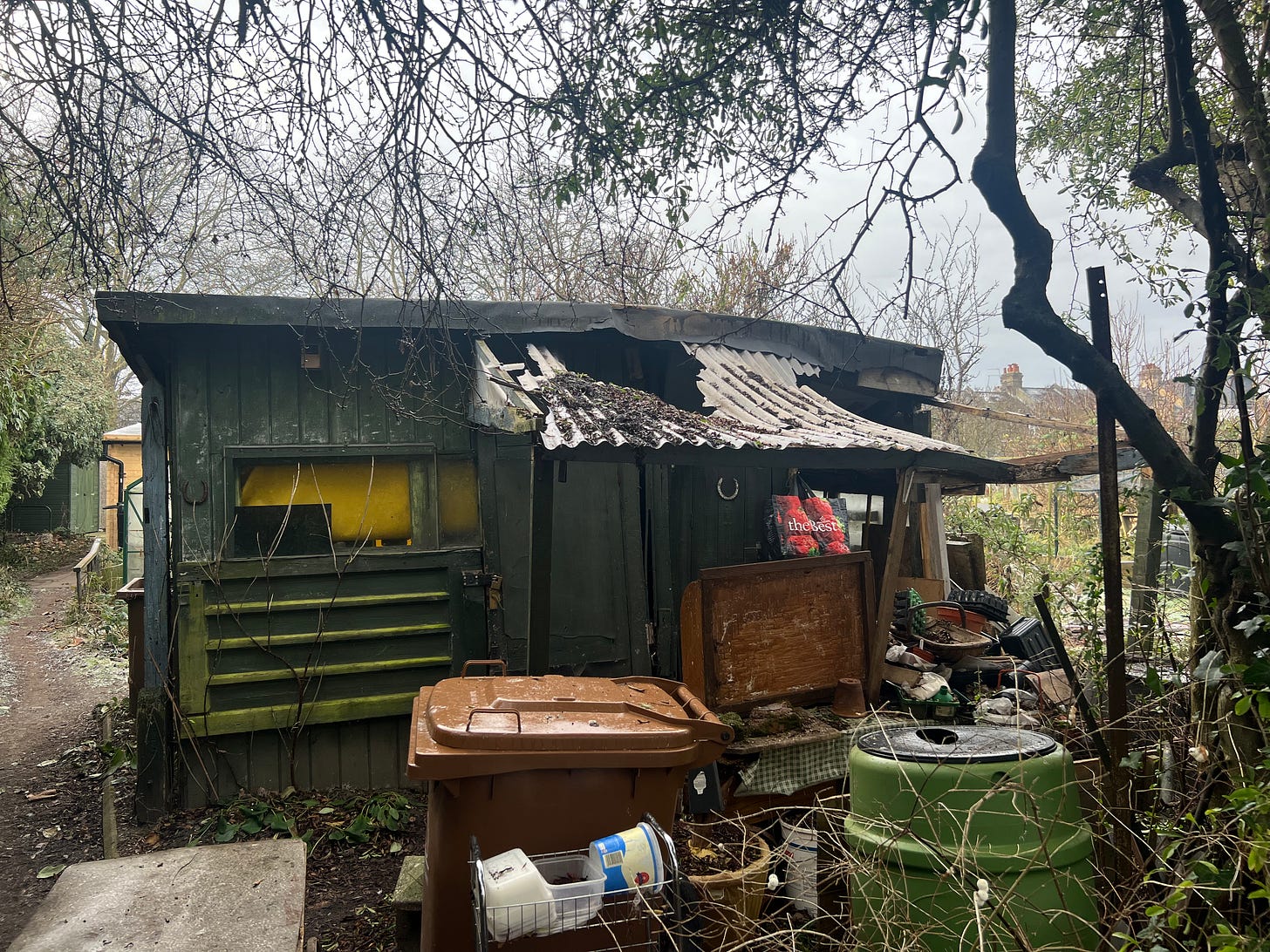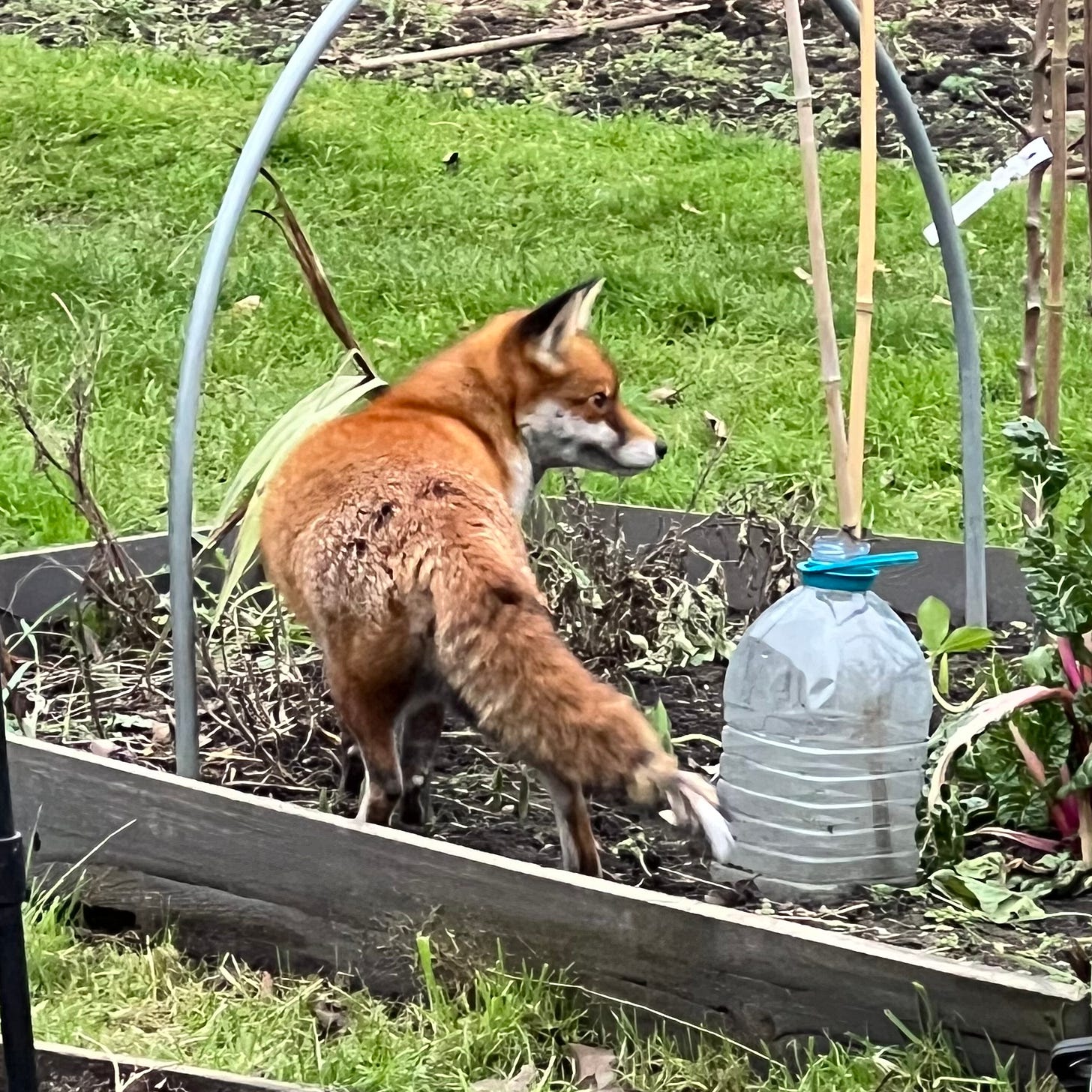I’m back! It has been a slog through the first three weeks of the new year, when work on the plot has been bone cold and saturated with slow-seeping damp on grey days. Cold days without the damp have been the better option. But there have been days to work on, and the quiet nagging of my list of jobs still to do has driven me out into Walthamstow’s version of Scottish dreich.
There’s not our usual rhythmn of harvesting and making from plot produce at this end of winter, but it is the best time to get large maintenance jobs done, and the gang have been chipping in to sort out jobs which have been waiting for several years. Everyone seems to have something needing doing which, looking back, should really have been done in the Before Times, prior to the Covid pandemic, but of course the world stuttered and stopped in 2020. There’s a backlog of repairs and rebuilding to start off the new season, before the tsunami of sowing and planting hits us.
Plants & Practice is a reader-supported publication, free to everyone. If you’ve already subscribed - hurrah! and thank you! - a new episode should pop into your inbox each week from now on. If not, click to enter your email here and join the allotment gang.
(Technical note: there are usually a *lot* of photos in these posts, and they might not all fit on your email. Hitting the View Entire Message button at the end should sort this out, as will reading via the app or online versions of Substack.)
This week’s Plot Shot
Being in London, where clear views of the night sky are typically blighted either by light pollution or close-packed buildings, we’ve had some luck at spotting various planets on evenings when the sky has been clear. This bright dot is Venus, above the moon, and very clear even on a smart phone camera.
We’ve not had clear skies on the nights when the Quadrantid meteor showers have been expected, but amateur astronomer friends tell me that there’s quiet a planetary parade over the course of this month, with several planets all lining up across the January sky. I could be seriously tempted to buy a telescope for the clear nights on site.
Plot work in progress
On the ground, we’ve been using the winter days to catch up on maintenance of sheds. Slow, methodical work to mend and make good in my case, shoring up decaying woodwork to keep it going for another few years yet and stave off the inevitable eventual shenanigens of replacement.
Said shed now has a smart skirt of heavy duty black plastic sheeting, stapled around the base and flared out to (I hope) stop the wet getting into the lower boards and rotting them any more than they already have. It is a long way from perfect, but it will do the job for a year or two. If only I’d thought of doing this when the shed was first built, it would be in better shape now, but I didn’t think of this until faced with the rot problem. Mother of invention, and all that.
Having wrestled with the plastic sheeting (in a ‘light breeze’, per the weather forecast, just for the fun of it) and skirted around all four sides of the shed, a cavalry of willing hands arrived to help cut and screw sections of old skirting boards around the base.
Reassembled, repainted and plastic trimmed, the old shed isn’t too bad. (I’m told that my plot colour scheme is has now moved to purple with an accent of downpipe grey, which could be a challenge to replicate in the plot’s planting scheme.) Just the sections of rotten window frame to repair and the broken window to replace and the shed is fully back in business. I say ‘just’, because that’s the trickiest bit of the job still to do. I’ve covered it over with the last of the plastic for now, leaving the wood to dry out for a week or so before tackling that job.
Of course, doing anything on an allotment is a challenge. First, there is no mains power. Hand or battery-operated tools are the only option, and while we have sheds to store our gardening tools (or perhaps a telescope), the site doesn’t have a communal workshop space with benches and tools to make repairs out of the weather. Everything gets done out on the plots, planks of wood, boxes of screws and pots of paint balanced on whatever is around.
Several years ago, husband Clive and I built a small greenhouse (or, more properly, a glasshouse) on our plot from a proper swanky kit we’d bought online in a rush of new plotholder enthusiasm. We opened the instruction booklet and read that we would need a piece of open ground that was level, and that the panes of glass would only fit properly in the metal frame if it was assembled correctly in all its dimensions: level, straight and true.
Oh, how we laughed. Nothing is ever level, straight and true on an allotment. I still have the photos of us putting the greenhouse together. It is probably a good How Not To Do It story of heroic stupidity, ripe for another post.
Harvesting now
Given the alternating dreich and freeze in E17, there has been no harvesting, and we’re starting the 2025 plot produce count with a zero, resetting for the new year1. I’ve not touched any of the plants we have growing, not wanting to damage them if they’re frozen. The broad beans, artichokes and chard will have to take their chances and sort themselves out. Or they won’t. I can’t help them at this point, they’ll either prove to be frost hardy or not.
But I won’t deny that on frost days we’ve celebrated the likely demise of slug and snail eggs in the sub-zero cold, stamping to keep our feet warm while holding mugs of steaming soup. There’s even been the odd tot of sloe gin, plastic shot glasses raised to cheer the not-so-dearly departed gastropods after a minus five degrees overnight.
Making and eating
Winter citrus have saved us from the grey and the gloom, blood oranges brightening the pavement display outside the local Turkish corner shop.
Adopting a ‘work with what you have’ approach, husband Clive tweaked a trusty Mary Berry recipe for lemon drizzle loaf cake into a blood orange drizzle. Here’s the juice about to be drizzled, pure liquid sunshine.
Needless to say, a fresh cake, still warm from the oven, lasts seconds on an allotment. This one kept the shed repairs going on a particularly gloomy afternoon, when temperatures were barely above freezing.
E17 Local Hero
Apart from the heroic efforts of shed repairs, this year’s house amaryllis has been maintaining high flowering standards from the kitchen table.
The flowers are starting to fade now, but this amaryllis has been a beauty. Two stems of deep red, dinner plate sized blooms, with an enamel sheen on the petals. I’ve made a note to buy more next year. An extravagance of three fat bulbs, planted in succession to see us through the dark weeks and three amaryllis won’t cost as much as a telescope.
Community of Practice
When not shoring up our shed on Plot 101, the gang have all chipped in to repair sheds and get heavy jobs done on neighbours’ plots, many hands making lighter work even if we can’t generate more daylight. Here’s our main target for improvement, which is taking more than a lick of purple paint to get back into shape.
This is one of the sheds which needed a refurbishment in the Before Times, before the pandemic hit in 2020. Since then, folk have struggled, several of us have been unwell or dealing with family things, and time has ticked on. Paint has peeled, old wood has rotted in the wet and corrugated plastic sheets have shattered, weakening in sunlight and breaking as overhanging branches have collapsed on them.
What’s great about working on allotment jobs together is that eveyone has different skills and practice to contribute. The word ‘bodge’ has a firm place in the Allotment Dictionary (Walthamstow, 2025 edition), but I’m not convinced that it necessarily means to make or mend something badly, or in a way that is not as good as it should be. Sometimes, ‘bodging’ is just the allotment way of working out how to get a job done at all, with what’s available, and whether it can be done takes some trial and error. Learning by doing, through practice.
We share what tools we have, passing the one decent (non-pruning) wood saw or the only spare battery for the cranky screwdriver from hand to hand, and plot to plot. There’s a lot of ‘Hang on, I’ve got a spare piece of wood that will fit that’ or ‘How about if we try this?’. We’ll get there with this shed over the next few weeks. Watch this space.
Weekly Fox News
While the humans have been disrupting quiet shed decay, our fox family are preparing for mating season. The vixens have marked out their spots now, most are digging dens for cubs, and the males (the dogs) are hanging around, generally taking up space and waiting for the action to start. This is Nellie, the vixen with her den closest to our plot. She’s buried pieces of raw chicken in almost every one of our raised beds, storing up food for later amongst the chard and tulip bulbs.
Until next week, I hope everyone knows where their chicken pieces are buried.
Ang
Total for January to date, null points, making the total produce tally for the first three weeks of 2025 in this post, re-starting from Episodes #22, £0.00. Fruit, veg and produce prices based on current supermarket or local farmers’ market prices. 2024’s weekly average produce value was £12 per week, so I’m looking for a big improvement in 2025 with better planning.

